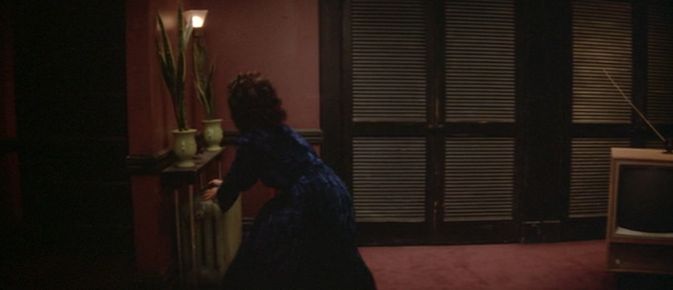 Back to selection
Back to selection
The Blue Velvet Project
Blue Velvet, 47 seconds at a time by Nicholas Rombes
The Blue Velvet Project, #54

Second #2538, 42:18
Frank has arrived, banging on the door. The fact that we anticipated his arrival makes it no less terrifying. Jeffrey—naked—has been shuttled into the closet, while Dorothy ditches the knife behind the radiator, in one of Blue Velvet’s many sly, tension-breaking references to Eraserhead. In Art and Fear, Paul Virilio reminds us that the coming of sound in film in the late 1920s effectively transformed silence into something alien, almost a special effect:
Yet one crucial aspect of this mutation of the seventh art has been too long ignored and that is the arrival of the talkies. From the end of the 1920s onwards, the idea of accepting the absence of words or phrases, of some kind of dialogue, became unthinkable. The so-called listening comfort of darkened cinema halls required that hearing and vision by synchronized.
In a universe just one Higgs boson particle different from ours, Blue Velvet could well be a dialogue-free movie (operating in the same secret wavelengths as Godard’s Band à parte), the clash of archetypal characters whose facial expressions, tics, dress, and body language suggest a totalitarianism of signs. For this brief moment, the levels of knowledge work something like this:
1. Dorothy knows that Jeffrey is in the closet (and that he does not know Frank or the meaning of Frank) and that Frank is at the door (and that Frank does not know that Jeffrey is in the closet).
2. Jeffrey knows that someone is at the door, probably the person whose voice he could not hear (from the closet, earlier) Dorothy talking to (“yes, sir”) on the phone.
3. Frank, when he enters, does not know that Jeffrey is in the closet.
4. So, at this point, the audience’s knowledge is, for the most part, as restricted as Jeffrey’s.
And more on silence: the differences between the sounds emitted by the VHS player and the DVD player, and our associations with those sounds, our connections with the technologies of viewing make the silence of the film never completely silent. At this moment in Blue Velvet, there is no soundtrack, and no dialogue. There is only the metallic sound of the knife tumbling behind the radiator, the pounding on the apartment door, and the swoosh of Dorothy’s movement across the room. (And there is the sound of terror, which cannot be measured.) And yet if you watch this scene, wherever you are, you inevitably will bring your own soundtrack to the unfolding images: the rain outside your window, the noise of traffic in the distance, the hum of a furnace, a song coming from another room, your very own blood, dear reader, coursing through your body.
A minute of silence from Godard’s Band à parte:
[jwplayer mediaid=”36205″]
Over the period of one full year — three days per week — The Blue Velvet Project will seize a frame every 47 seconds of David Lynch’s classic to explore. These posts will run until second 7,200 in August 2012. For a complete archive of the project, click here. And here is the introduction to the project.
